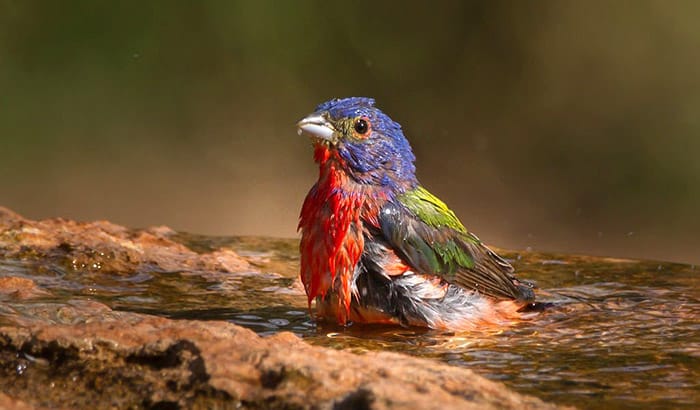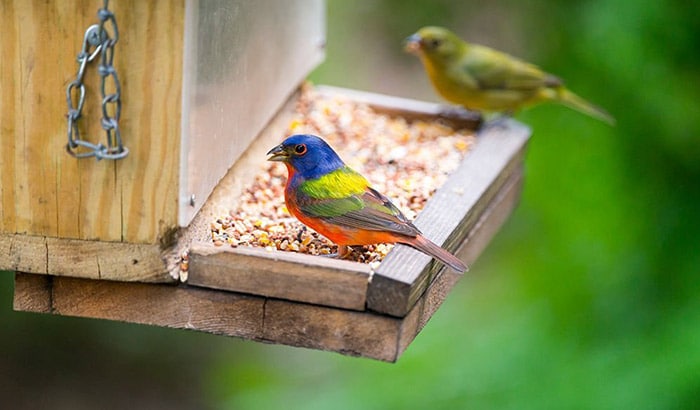One of the reasons why I like having birds visit my backyard is the color that they bring to the surroundings. One bird that I really like because of its vibrant color is the painted buntings. With its red underparts, yellow-green back, and blue head, this bird is a head-turner once it visits your garden.
But, how to attract painted buntings? Unfortunately, you will need a lot of patience to attract these colorful birds. Painted buntings are naturally shy and can easily be scared off. However, there are things that you can do in your backyard to lure these beautiful birds and play in the garden.
Contents
Where Do Painted Buntings Live
Painted buntings like to stay in thickets and woodlands with riparian thickets. They can also be found in places that are shrubbery and brushy. If you live in the eastern part of the United States, you will see the birds breeding in maritime hammocks and scrub communities.
In the United States, you will see these colorful birds in south-central states such as Oklahoma, Texas, Arkansas, and nearby places. They can also be seen on the Atlantic coast from North Carolina to Central Florida. If you are living in these places, you will probably have a greater chance to attract these birds using some tips we have listed below:
Painted Buntings are Seed Eaters
One way to attract painted buntings is to provide them with the foods they like. Painted buntings are seed eaters, which means they want to go to bird feeders and eat. In particular, they like to devour millet seeds in their meals. Using seed mixes can also gain their interest in your backyard.
But in the spring season, these birds will not limit their food to seeds. They will also try to look for insects to bulk themselves so that they will be prepared during migration. But some adult birds will still look for seeds to feed their baby birds.
Bird Feeder for Painted Buntings
Since painted buntings like to eat seeds, it is essential to use a bird feeder that they want, for them to come and eat the seeds that they like. Painted buntings are generally shy and easily scared, so a caged feeder will be perfect for them.
A feeder with a protective cage will keep them protected from large and bully birds as well as other predators. The feeder should also have perches because that is also the preference of painted buntings.
Water Source is also Essential
Putting a water source in your backyard will also help attract these colorful birds. So, a birdbath will be useful to provide them with a source of water. But do not forget that the water should be clean and fresh all the time.
You can also have the option to put a birdbath with a fountain. A fountain’s benefits will also help lure these bright and beautiful flyers. Moving water in the fountain will attract the painted buntings more, and it also eliminates the chance of spreading disease and bacteria.
A shallow basin is enough for the birds to drink quickly when looking for the right birdbath. You do not need a deep basin because these birds are literally small. Positioning the birdbath is also essential, and the ideal position is under the shade to control the growth of algae and bacteria.
Make your Backyard Perfect for Painted Buntings
In terms of shelter, painted buntings like to live in a place with huge covers to protect themselves from predators. So, it would be best if you made your backyard with low dense vegetation by planting native grasses and shrubs.
Since they need to feel secure before coming out in the open, they need to have enough cover for protection. If your place comes with large live oaks, they will readily use it for cover. They can also make other species of oaks, hackberry, and other sizable native hardwoods as their shelter.
Nesting Sites for Painted Buntings
When it comes to their nesting, painted buntings are generally shrub and scrub nesters. So, they like to nest not more than 6 feet from the ground. So, you will need to make your backyard more dense, shrubby, and grassy.
More importantly, during the nesting period, you must increase the dense shrubs in the landscape of your area. You can also plant small trees and evergreens to provide protection to the birds while they are nesting.
You can also plant more tall native grasses to provide additional habitat to the birds. Also, even if there are no trees near your backyard, trees within the area can also help protect the birds as long as it is not more than 40 feet.
Conclusion
If you want to learn how to attract buntings, you need to be patient about it. These colorful singing birds are naturally shy and can be scared easily. So, you must make your backyard perfect for them by providing enough protection while they secure their food and water requirements.


